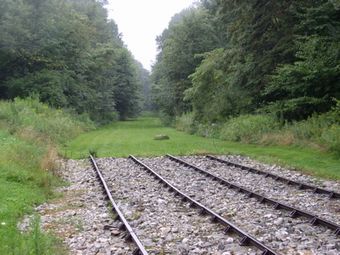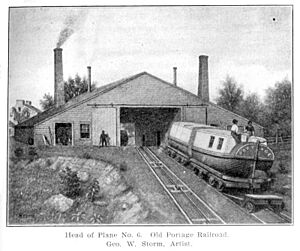Allegheny Portage Railroad facts for kids
|
Allegheny Portage Railroad
|
|

Incline 6 Trail and Recreated Tracks
|
|
| Location | Blair and Cambria counties, Pennsylvania, United States |
|---|---|
| Nearest city | Altoona, Pennsylvania, U.S. |
| Area | 1,296 acres (524 ha) |
| Built | 1831-1834 |
| Architectural style | Wood, Stone, Wrought Iron |
| Visitation | 118,931 (2009) |
| Website | Allegheny Portage Railroad National Historic Site |
| MPS | Allegheny Portage Railroad MPS |
| NRHP reference No. | 66000648 |
Quick facts for kids Significant dates |
|
| Added to NRHP | October 15, 1966 |
| Designated NHL | December 29, 1962 |
The Allegheny Portage Railroad was a very important railroad built a long time ago. It was the first railroad to cross the Allegheny Mountains in central Pennsylvania. From 1834 to 1854, it helped connect the Midwest to the East Coast.
This railroad was about 36 miles (58 km) long. It linked up with the Pennsylvania Canal on both ends. Its main job was to carry river boats and barges over the mountains. This helped move goods between the Ohio River and the Susquehanna River.
Today, you can still see parts of this old railroad. They are protected at the Allegheny Portage Railroad National Historic Site. The National Park Service takes care of it.
The railroad was a big part of the "Main Line of Public Works" plan from 1824. It had five steep sections, called inclines, on each side of the mountain top. These inclines helped move boats up and down the slopes. The railroad connected Johnstown in the west to Hollidaysburg in the east.
Special wheeled barges rode on narrow tracks. Powerful steam engines pulled these barges up the steep inclines. Other parts of the railroad were flatter. On these sections, animals like mules pulled the boats. It was like a giant puzzle of flat paths and steep hills!
This railroad worked in almost all kinds of weather. It made travel from Philadelphia to the Ohio River much faster. What used to take weeks now only took 3 to 5 days! People thought it was an amazing invention back then. It helped open up the middle of the United States for people to settle and for businesses to grow.
It even had the Staple Bend Tunnel, which was the first railroad tunnel in the United States. When it first opened, people celebrated a lot!
Contents
Building the Allegheny Portage Railroad
Building the Old Portage Railroad was a huge job. It started in 1831 and took three years to finish. The railroad stretched 36 miles (58 km) from Hollidaysburg to Johnstown. It included a tunnel 900 feet (274 m) long. There was also a bridge, called a viaduct, over the Little Conemaugh River.
The railroad climbed 1,172 feet (357 m) from Johnstown. From Hollidaysburg, it climbed even higher, 1,399 feet (426 m). The state of Pennsylvania paid for this project. They wanted to compete with other big canals and railroads in New York and Maryland. Private companies did most of the building work.
The railroad used eleven regular tracks and ten cable inclined planes. There were five inclines on each side of the Allegheny Mountains. These inclines carried loaded canal boats on special flatbed railroad cars. Mules pulled trains of two or three cars on the flatter tracks. On the steep inclines, stationary steam engines pulled cars up and down using thick ropes.
A Marvel of its Time
The entire "Main Line" system connected Philadelphia and Pittsburgh. It was about 400 miles (644 km) long. A trip that used to take 23 days by horse and wagon now took only 4 days! People called the Old Portage Railroad "the wonder of America."
A famous writer named Charles Dickens traveled on the railroad in 1842. He wrote about his journey in his book American Notes. He described how exciting it was to travel high up in the mountains. He saw valleys below and small cabins through the trees. He also found it funny to see the steam engine, after dropping off the cars, "come buzzing down alone, like a great insect."
Why the Railroad Changed
By the 1850s, new railroad technology made the Portage Railroad less useful. Trains could now go faster and climb mountains more easily. In 1846, the Pennsylvania Railroad (PRR) was created. It planned to build a railroad across the whole state.
By December 1852, PRR trains were running between Philadelphia and Pittsburgh. This cut travel time from 4 days to just 13 hours!
A new, longer railroad was built to go around the steep inclines. This "New Portage Railroad" started in 1851. The Pennsylvania Railroad became very successful. In 1857, they bought the old Portage Railroad from the state. The PRR then stopped using most of the old line. They took away anything valuable from it.
Later, in 1904, parts of the old railroad were used again for freight trains. But in 1981, the line to Hollidaysburg was finally closed. In 1987, the Allegheny Portage Railroad was named a National Historic Civil Engineering Landmark. This showed how important it was in engineering history.
Visiting the Historic Site
The National Historic Site was created in 1964. It covers 1,296 acres (524 hectares) and is about 12 miles (19 km) west of Altoona. The National Park Service has a visitor center there. You can see exhibits that explain the railroad's history.
Nearby is the Samuel Lemon House. This old tavern was a popular stop for railroad passengers. Today, it's a museum run by the National Park Service. The park also has a rebuilt section of track and an engine house with more exhibits. There are picnic areas and hiking trails too.
You can also see a special bridge called a skew arch bridge. It's made of carefully cut stone and is very impressive. It was the only bridge on the line built to carry a road. The Staple Bend Tunnel is also part of the historic site. It's about 5 miles (8 km) east of Johnstown.
Gallery
See also














